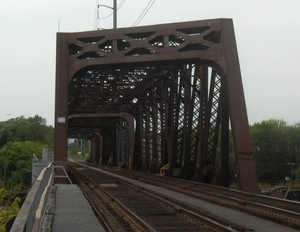B&O Railroad Bridge
B&O Railroad Bridge | |
|---|---|
 B&O Railroad Bridge looking southwest | |
| Coordinates | 39°56′08″N 75°12′21″W / 39.93556°N 75.20583°W |
| Carries | Railroad |
| Crosses | Schuylkill River |
| Locale | Grays Ferry neighborhood in Philadelphia, Pennsylvania |
| Other name(s) | CSXT Schuylkill River Bridge |
| Owner | CSX Transportation |
| Characteristics | |
| Design | Through truss swing bridge |
| Piers in water | 3 |
| History | |
| Fabrication by | American Bridge Company |
| Opened | 1910, rehabilitated May 2004 |
| Location | |
 | |
The B&O Railroad Bridge (also called CSXT's Schuylkill River Bridge) is a 1910 swing bridge across the Schuylkill River from Bartram's Garden on the west bank to the east bank Grays Ferry neighborhood of Philadelphia, Pennsylvania. It carries CSX Philadelphia Subdivision rail lines over the river,[1] and sits upstream from the Passyunk Avenue Bridge and downstream from the Grays Ferry Bridge.

Construction and history[edit]
It is the second bridge to occupy this location. The Baltimore and Ohio Railroad built the original one in the 1880s, after losing a stock takeover battle for its main route into Philadelphia, the Philadelphia, Wilmington and Baltimore Railroad. The winner, the rival Pennsylvania Railroad, gave the B&O until 1884 to build its own southwest line into the city before cutting off access.[2]: 154
The new route required a new bridge over the Schuylkill to replace the use of the PW&B's Gray's Ferry Bridge, and so the B&O built a four-span iron through truss bridge with a center swing span to allow boats to pass.[3][4] It opened on July 11, 1886.[5] (The cost of building the new route, especially the Howard Street Tunnel on the connecting Baltimore Belt Line, led to the B&O's first bankruptcy.)
In 1910, the B&O replaced the original bridge with the current one. The three-span through truss bridge with a center swing span was built by the American Bridge Company. During construction, a tugboat grounded on the nearby riverbank and was freed by a B&O locomotive.[6]
The bridge was struck by the tugboat Radnor, hauling a barge loaded with oleum, on March 12, 1924.
The bridge was originally protected by a mechanical interlocking, which was revised in 1914.[7] It was replaced in 1946 with an electrical interlocking, which also controlled the nearby junction with the Reading Company at Eastwick.[8]
Modern rehabilitation[edit]

In 1977, the Chessie System, then-owner of the bridge, did engineering studies of the swing bridge mechanisms and determined that extensive rehabilitation was needed. Yet the project was placed on hold for decades, despite associated FRA violations and operational difficulties.
In late 2003, Chessie successor CSX Transportation finally undertook the renovation. The project included extensive work on the miter rails, the mechanisms that allow the rails to be connected and disconnected as the bridge is opened and closed. Because the bridge could not be opened during construction, close coordination was required between the contractors; CSX, which controlled rail traffic; and the U.S. Coast Guard, which controlled marine traffic.[1] The rehabilitation was completed on time in May 2004.[9]
See also[edit]
References[edit]
- ^ a b Judge, Tom (October 2004). "Shaping up bridge for second 100 years; CSXT's Schuylkill River bridge in Philadelphia carries heavy volumes of traffic, but needed rehab to do the job into a second century". Bnet: Reference Publications. Simmons-Boardman Publishing Corporation. Retrieved 2010-07-15.
In 1910, the Baltimore & Ohio constructed a two-track swing bridge spanning the Schuylkill River in Philadelphia.
- ^ Stover, John F. (1987). History of the Baltimore and Ohio Railroad. West Lafayette, Ind.: Purdue University Press. ISBN 0-911198-81-4.
- ^ Harwood, Herbert H. Jr. (2002). Royal Blue Line: The Classic B&O Train between Washington and New York. Foreword by Courtney B. Wilson. Baltimore, Md.: Johns Hopkins University Press. p. 44. ISBN 978-0-8018-7061-3.
- ^ Patton, William Macfarland (1893). A Practical Treatise on Foundations. New York: John Wiley & Sons. p. 130. OCLC 3490768.
- ^ NRHS Bulletin. 38. National Railway Historical Society: 42. 1973.
{{cite journal}}: Missing or empty|title=(help) - ^ Eberwein, William F. (December 1910). "Engine Tows a Boat". Railway and Locomotive Engineering. 23: 492.
- ^ "Summary of Signal Work in 1914". Railway Signaling and Communications. 8: 22. January 1915.
- ^ Railway Age. 121: 314. 1946.
{{cite journal}}: Missing or empty|title=(help) - ^ "RIDEX INSTALLATIONS, SCHUYLKILL RIVER SWING BRIDGE, PHILADELPHIA, PENNSYLVANIA". CMI-Promex, Inc., 7 Benjamin Green Road, Pedricktown, NJ 08067. 2004. Archived from the original on 2010-07-15. Retrieved 2010-07-15.
Four photos of miter rails installed on the bridge
